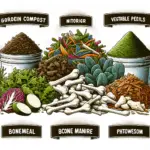As temperatures drop, succulent enthusiasts face a pressing question: can succulents survive winter? These resilient plants, known for their ability to store water, require proper care and adjustments during colder months. Our guide delves into essential tips and strategies to ensure your succulents endure the chill, drawing on expert advice and practical solutions. From choosing the right varieties to indoor and outdoor care, discover how to keep your succulents healthy and thriving, no matter how low the thermometer goes.
Understanding Succulent Hardiness Zones
Succulents are known for their resilience, but like all plants, they have limits when it comes to cold tolerance. Understanding succulent hardiness zones is essential to ensure your plants can thrive year-round. These zones are geographic areas defined by the minimum temperatures a plant can withstand. Succulents are often associated with warm, arid climates, but many can adapt to colder areas if properly managed.
Hardiness zones range from 1, the coldest, to 13, the warmest. Each zone represents a 10°F difference in average annual minimum temperature. To determine which succulents can survive winter outdoors, you need to identify the lowest temperature your area experiences and choose plants suited to this climate.
Cold-Hardy Succulent Varieties
Some succulents, such as Sempervivums and Sedums, have evolved to handle cold better than others. These plants have adaptations that allow them to withstand freezing temperatures, such as thicker leaves or characteristics that allow them to retain moisture longer. When choosing succulents for zones with harsh winters, always check their hardiness rating.
Zone-Specific Care Tips
It’s not just about picking the right plant, but also about caring for them accordingly. In colder zones, create a microclimate by positioning your succulents in a sunny, sheltered spot. Mulching can also help insulate the roots from extreme cold. Additionally, ensuring your plants are properly hydrated before the onset of cold weather can prevent damage. However, avoid overwatering as this can freeze and damage the plant cells.
By understanding these zones and selecting the right succulents, you can enjoy these beautiful plants even through the frostiest months of the year. Always cross-reference your local zone with the specific needs of your succulents to provide optimal care.
Best Practices for Protecting Succulents in Winter
When winter approaches, it’s crucial to adapt your succulent care routine to prevent cold damage. Start by understanding your succulent’s hardiness zone. Hardiness zones help determine how much cold a plant can tolerate, and succulents vary widely in their cold hardiness.
Protection strategies are essential when temperatures drop. If succulents are planted outdoors and temperatures fall below their tolerance, consider using protective coverings such as frost cloths or burlap. These materials create a barrier against cold winds and frost.
For indoor succulents, ensure they are placed in a well-lit area. Sunlight is limited in winter months, so placing them near a south-facing window is advantageous. Alternatively, use grow lights to supplement their light needs. These lights mimic sunlight and ensure your succulents get adequate light exposure to stay healthy.
Another key factor is soil and drainage. Proper drainage is crucial year-round but especially during winter to prevent root rot. Use cactus soil or a well-draining potting mix. Avoid letting the pot sit in water, and be cautious not to overwater, as wet soil in cold conditions can harm succulents. Consider reducing watering frequency as succulents enter a dormancy phase.
Finally, incorporating microclimates can make a big difference. Planting succulents in sheltered spots near walls or rocks can help them retain heat and offer some protection from winter elements. This strategic placement can create a warmer environment that aids in their survival.
Which Succulent Varieties Can Tolerate Cold Temperatures?
Which Succulent Varieties Can Tolerate Cold Temperatures?
While most succulents thrive in warm weather, some varieties are surprisingly adept at surviving cold conditions. These hardy types not only tolerate but often thrive in cooler climates where frost is common. Among the most resilient are Sempervivum (also known as hens and chicks), which can withstand freezing temperatures due to their alpine origins. They are especially known for their rosette forms, which help protect the inner core from harsh winds and cold.
Another cold-tolerant succulent is Sedum, particularly the ground-covering varieties. These succulents often develop a protective layer or alter their pigmentation, turning a reddish hue to reduce water loss and damage from cold. Sedum is perfect for stone gardens or rockeries, as they can endure tough winter climates.
The Agave plant, specifically Agave parryi, is another succulent that can brave the cold. Known for its rigid, blue-grey leaves, Agave parryi is native to high desert environments. Its structure naturally helps it shed snow, reducing the risk of rot and cold damage.
However, proper care during especially harsh winters is vital. Even these adaptable plants require some assistance to thrive year-round. Providing adequate shelter from harsh elements, ensuring well-draining soil, and occasionally using frost cloths can enhance their resilience significantly.
Signs That Your Succulent Is Struggling in Winter
Observing your succulents closely during the winter months can reveal key signs of distress. Changes such as discoloration of leaves may indicate that your succulent is too cold. Brown or black leaves can signify frostbite, while yellowing might suggest overwatering. Another major sign is if the leaves start to drop off more frequently than usual.
Pay attention to the plant’s general appearance and texture. Wrinkled or mushy leaves are a telltale sign of excess moisture in the soil, which can be exacerbated by the cold. You might also notice a slower growth rate. This is a natural response to the lack of sunlight and lower temperatures, but if paired with other symptoms, it could mean your plant is struggling more than usual.
During winter, succulents should be firm and upright. If you notice wilting, it may be due to root rot, caused by poor drainage or overly wet conditions. Checking these signs regularly will help you take the necessary steps to improve your succulent’s environment and ensure their survival through the colder months.
How to Prepare Your Succulents for Winter Dormancy
As temperatures drop, succulents undergo winter dormancy, a phase where they reduce growth and conserve energy. Preparing succulents for winter dormancy is integral to their survival and spring revival. Here’s how you can ensure your succulents thrive during cold months:
Gradual Acclimation
Begin by gradually acclimating your succulents to lower temperatures. Move them to cooler areas over several weeks rather than sudden exposure to cold. This helps them adjust without going into shock.
Adjust Watering Schedule
As succulents enter dormancy, they require less water. Reduce watering frequency, allowing the soil to dry out completely between waterings. Overwatering can cause root rot, especially in cooler conditions.
Control Light Exposure
Ensure succulents receive adequate sunlight, ideally six hours a day. If you notice your succulents getting leggy, consider using grow lights to supplement natural light.
Temperature and Humidity
Maintain a consistent temperature avoiding drastic fluctuations. Keep indoor succulents away from drafty windows or heat sources. While humidity isn’t a major concern for succulents, ensure good air circulation to prevent mold.
Soil and Drainage
Good drainage is crucial during dormancy. Ensure your succulents are planted in a well-draining soil mix. Consider adding sand or perlite to improve drainage if necessary.
By following these steps, your succulents will be well-prepared to endure the winter dormancy and thrive once the warmer temperatures return.
Indoor vs. Outdoor Succulent Care During Winter
Indoor Succulent Care
During winter, indoor succulents need special attention to ensure their survival. Place them near a bright window where they can receive ample sunlight, as these plants thrive on light even in colder months. Consider using grow lights if natural light is insufficient. Maintain a temperature range between 60-75°F and avoid placing them near drafty windows or heating vents, which can harm them.
Watering should be reduced, as succulents require less moisture during winter dormancy. Overwatering is a common mistake, so allow the soil to dry out completely between watering sessions. Use a potting mix with excellent drainage to prevent root rot.
Outdoor Succulent Care
Outdoor succulents face harsher conditions during winter. Protect them by moving potted succulents to a sheltered location or using frost cloths to cover them during cold nights. Make sure they are planted in well-draining soil to avoid waterlogged conditions, as freezing moisture can be deadly.
Some succulents can tolerate brief cold spells, but monitoring the weather and providing extra insulation when necessary is essential. For succulents planted in the ground, adding a layer of mulch around the base can offer additional protection from frost.
Understanding the differences in care for indoor and outdoor succulents during winter can significantly increase their chances of surviving until spring.
Using Microclimates to Help Succulents Survive Winter
During the colder months, creating microclimates can be a lifesaver for succulents. Microclimates are small, specific areas where the environmental conditions vary from the surrounding area. These can be as simple as a sunny windowsill or a sheltered spot on a porch. They provide a slightly warmer environment that can help succulents thrive even when winter temperatures dip.
One effective way to establish a microclimate is by using cold frames or cloches, which trap heat and create a mini greenhouse effect. These protective coverings should be placed over the succulents during nighttime to ward off frost.
Consider positioning your succulents near heat-retaining surfaces like brick walls or concrete patios. These surfaces absorb heat during the day and slowly release it throughout the night, helping maintain a warmer climate around your plants.
Strategic placement of rocks around succulents can also help. Rocks absorb heat from the sun and radiate it back to the plants, creating a warmer surrounding environment.
To maximize your efforts, pay attention to natural windbreaks, such as hedges or walls, that mitigate harsh winter winds. These elements can contribute significantly to the success of your succulents during cold spells.
Winter Watering Tips for Succulents
To ensure succulents thrive during winter, adjust your watering habits to suit their needs. Water your succulents sparingly, as they require less moisture in colder months due to slower growth. Overwatering can lead to root rot, especially when the temperature drops. Typically, once every four to six weeks is adequate, but this may vary based on specific conditions such as humidity and indoor heating.
Check the soil moisture before watering by inserting a finger into the soil. If it feels dry several inches deep, it might be time to water. Use lukewarm water instead of cold, as it is gentler on the roots. Always water at the base of the plant rather than overhead to avoid moisture pooling on the leaves.
If your succulents are kept indoors during winter, consider the impact of indoor heating, which can dry out the air and soil. Positioning a humidifier nearby can help maintain adequate humidity levels. Using pots with drainage holes is crucial to prevent waterlogged soil, allowing excess water to escape, thus protecting the roots.
Avoid fertilizing your succulents during winter months, as they are in a dormant state and do not need additional nutrients. By following these watering tips, you can help your succulents survive the winter chill and emerge strong in the spring.
How to Recognize Frost Damage in Succulents
Frost damage in succulents can be tricky to spot at first. One of the main signs is discoloration of the leaves. Succulent leaves may turn odd shades of brown, black, or even translucent when frostbite occurs. This happens because the water inside the leaves freezes, expands, and ruptures the cells.
Another indicator of frost damage is the presence of wilted or mushy leaves. When the sun comes out after a frosty night, these leaves can start drooping or feel soft to the touch. Over time, these sections may rot and fall off if not treated.
Protecting Succulents from Further Frost Damage
It is important to move succulents indoors or to a more sheltered area during cold nights. You can cover them with frost cloths or blankets during the night and uncover them during the day to help minimize exposure. Avoid watering them right before a frost, as excess moisture can exacerbate damage.
When frost damages leaves, it’s often best to leave the damaged parts until warmer weather comes. Premature pruning can sometimes cause more harm than good, as the healthy areas can protect the plant’s core until conditions improve.
Observing and reacting swiftly to these signs will give your succulents a higher chance of surviving the winter and thriving again come spring.
The Role of Soil and Drainage in Winter Survival
Soil and drainage are crucial for ensuring succulents thrive during the colder months. Unlike other plants, succulents require a specific type of soil that allows for quick drainage. This is because excessive moisture can lead to root rot, especially when the temperatures drop. The ideal soil mix for succulents is one that is gritty and porous, such as a combination of sand, perlite, and cactus mix. Good drainage helps prevent water from sitting around the roots.
During winter, it’s vital that the soil doesn’t retain too much water. If you’re growing succulents in pots, make sure there are plenty of drainage holes. Containers with just one hole might not provide adequate drainage, so consider using pots with multiple holes or add a layer of rocks at the bottom to assist in draining excess water.
It’s also essential to consider the natural environment. In places where the soil freezes, potting your succulents can be beneficial because you can move them indoors or to sheltered spots during extreme weather conditions.
Soil amendments like pumice or lava rocks
can also be added to improve aeration and drainage, providing a more resilient environment for your succulents.
Moreover, by ensuring proper soil and drainage, you create a foundation that lets succulents utilize stored water effectively. They can tap into their reserves as needed, ultimately supporting their ability to survive through cold spells.
Using Grow Lights for Succulents During Winter Months
During the winter months, the amount of sunlight is significantly reduced, which can affect the health of your succulents. Using grow lights can be an excellent way to provide the necessary light to keep your plants thriving. It’s crucial to select the right type of grow light for your succulents. LED grow lights are highly recommended due to their energy efficiency and ability to provide the full spectrum of light.
Position the grow lights 6 to 12 inches above the succulents and ensure they are on for about 12-14 hours a day. This setup mimics the natural sunlight conditions most closely. You should also consider their light intensity; succulents require bright light, comparable to a sunny day.
Additional Tip:
Placing a timer on your grow lights can help maintain a consistent light schedule, which is important for the growth cycle of succulents. Ensure that you turn off the lights at night to allow the plants to ‘rest’ as they would in nature.
By using grow lights effectively, you can ensure that your succulents not only survive but flourish throughout the darker months.
Common Mistakes to Avoid When Caring for Succulents in Winter
During winter, ensuring the survival of your succulents requires careful attention to their unique needs. One common mistake is overwatering. Succulents need much less water during their dormant winter period. Too much water can lead to root rot, especially if temperatures drop below freezing. Ensure the soil is completely dry before considering another watering.
Another error many make is ignoring light requirements. Even in winter, succulents need ample sunlight. Place indoor succulents near a window with plenty of natural light. For outdoor succulents, consider repositioning them to maximize sun exposure or using grow lights to supplement diminished natural light.
Failing to adjust for temperature changes can also harm your succulents. Ideally, outdoor succulents should be protected from extreme cold—especially frost. Use frost cloths or bring potted succulents indoors when frost risk is high.
Additionally, many plant enthusiasts overlook the importance of a well-draining soil mix. Good drainage is crucial all year, but particularly important in winter to prevent water retention that can damage plant roots. Check that your pots have drainage holes, and consider adding sand or perlite to improve soil drainage.
Avoid making sudden changes to care routines. Gradually acclimate succulents when moving them indoors for the winter or altering their care conditions. Sudden shifts can stress the plants.
By avoiding these pitfalls, you’ll help ensure your succulents remain healthy and robust throughout the winter months, prepared to thrive once spring arrives.
One of the best strategies to safeguard your succulents during the colder months is mulching. Use mulch to insulate the soil and protect the roots from freezing temperatures.
It’s also crucial to understand the concept of microclimates when caring for succulents outdoors. Place your plants near walls or fences that absorb heat during the day, creating a warmer environment at night.
Another effective approach is to cover your succulents when frost is expected. Use breathable materials like burlap or frost cloth. Avoid plastic covers as they can trap moisture and cause rot.
If you have potted succulents, move them indoors or to a sheltered area like a porch or greenhouse during extreme cold spells. Ensure your indoor spot has ample light to support your succulents’ needs.
It’s essential to adjust watering habits for winter as succulents require less moisture during this period. Overwatering can lead to root rot, so let the soil dry out between waterings.
Lastly, be cautious with fertilizer use. Succulents naturally enter a period of dormancy during colder months and don’t require additional nutrients. Wait until spring to resume regular feeding.







